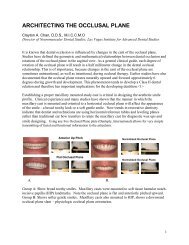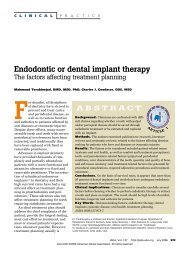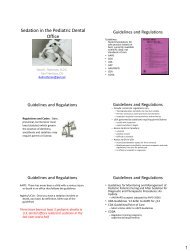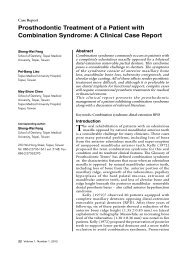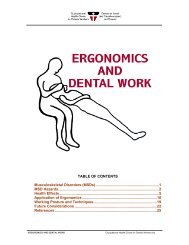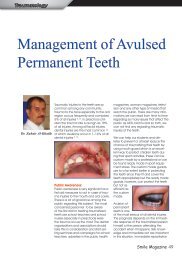BioDentine%20FBronnec%20case%20report%20ENG2
BioDentine%20FBronnec%20case%20report%20ENG2
BioDentine%20FBronnec%20case%20report%20ENG2
Create successful ePaper yourself
Turn your PDF publications into a flip-book with our unique Google optimized e-Paper software.
Endod. 2010;36:400–413.<br />
REYES-CARMONA JF, FELIPPE MS, FELIPPE WT. Biomineralization ability and interaction of<br />
mineral trioxide aggregate and white portland cement with dentine in a phosphate containg<br />
fluid. J Endod. 2009;35:731-736.<br />
TAY FR, PASHLEY DH, RUEGGEBERG FA, LOUSHINE RJ & WELLER RN. Calcium phosphate<br />
phase transformation produced by the interaction of the portland cement component of white<br />
mineral trioxide aggregate with a phosphate-containing fluid. J Endod. 2007;33:1347-51.<br />
TORABINEJAD M & MASOUD PARIROKH M. Mineral Trioxide Aggregate: A comprehensive<br />
literature review—Part II: Leakage and biocompatibility investigations. J Endod.<br />
2010;36:190–202.<br />
VALYI E. Ciments alcalins ou acides à usage odontologique : actions sur quelques souches<br />
bactériennes représentatives. Master thesis (Biomaterial Sciences). Université de Lyon 1.<br />
2009.<br />
WANG X, SUN H & CHANG J. Characterization of Ca3SiO5/CaCl2 composite cement for dental<br />
application. Dent Mater. 2008;24:74-82.<br />
WONGKORNCHAOWALIT N & LERTCHIRAKARN V. Setting time and flowability of accelerated<br />
Portland cement mixed with polycarboxylate superplasticizer. J Endod. 2011; in press :1–3.<br />
Captions and figures<br />
Fig. 1: Microscopic view of calcium-phosphate precipitates formed when the material is<br />
exposed to biologic fluids (MEB, x 500).<br />
Fig. 2: Quality of the material-dentin interface showing perfect adaptation and marginal seal<br />
of the filling (MEB, x 1000).<br />
Fig. 3:<br />
3a: Pretreatment radiograph.<br />
3b: Microscopic view of the perforation site.<br />
3c: Calcium hydroxide intracanal medication.<br />
3d & e: Repair of the perforation before obturation of the root canal.<br />
3f: Posttreatment radiograph<br />
3d: Radiograph at 3 months’ follow-up showing complete healing.<br />
Fig. 4<br />
4a: Pretreatment radiograph.<br />
4b: Perforation site viewed through the surgical microscope.<br />
4c & d: Microscopic view of the material in place after setting, and control X-ray film.<br />
4e: Posttreatment radiograph showing completed coronal restoration.<br />
Fig. 5



